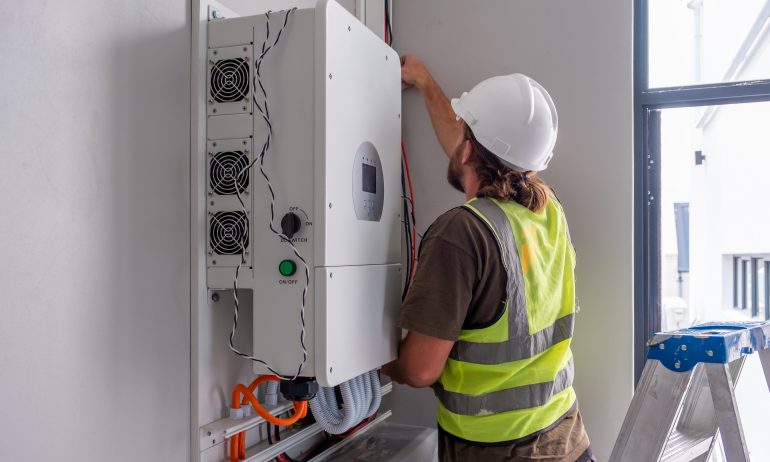Solar Inverters: How They Work, What to Know

Some or all of the mortgage lenders featured on our site are advertising partners of NerdWallet, but this does not influence our evaluations, lender star ratings or the order in which lenders are listed on the page. Our opinions are our own. Here is a list of our partners.
Solar inverters convert direct current (DC) power from solar panels into usable alternating current (AC) electricity. They do this by rapidly switching the direction of DC power back and forth, which creates a smooth AC electrical wave that’s compatible with the electric grid.
» MORE: Best solar companies of 2024
Solar inverters 101
Solar panels can only generate DC power, but most homes run solely on AC electricity. Enter solar inverters, which convert DC power to AC power. Inverters are key to making solar panels practical for everyday home use.
Inverter technology is actually nothing new — in fact, it’s been around since the nineteenth century. The earliest inverters were mechanical and relied on a spinning motor; today’s inverters use electrical switches from solid-state transistors with no moving parts.
Modern solar inverters may perform some other useful functions, too, such as:
Monitoring your solar photovoltaic (PV) system.
Acting as a portal for communication with computer networks.
Helping your system operate with no support from the grid if power outages occur.
Types of solar inverters
There are four basic types of solar inverters, plus a booster option called a power optimizer. Most inverters are engineered to work with the grid, although some may be appropriate for off-grid use, such as in remote cabins or RVs.
String inverters
What they do: The industry standard for most residential systems, string inverters connect multiple solar panels and send their DC power into a centralized inverter to create AC power that’s compatible with the grid.
Pros: String inverters usually cost less than other types of inverters, offer time-tested reliability and are typically conveniently placed for repairs and maintenance. One string inverter can connect up to 24 solar panels, and maintenance is simpler because fewer working parts are involved.
Cons: Because multiple panels act as a single unit, any issue (including shade) with any one panel affects all the panels. It can be hard to find the source of problems, because panels in this type of system can’t be monitored individually.
» MORE: How much do solar panels cost?
Microinverters
What they do: Microinverters attach to each individual solar panel in order to convert DC power into AC power.
Pros: Each panel’s efficiency doesn’t affect the others, which makes microinverters well-suited for situations in which some panels are under shade for part of the day. Microinverters also allow you to monitor each panel so you can address issues promptly. They make it easier to expand your system by adding additional panels.
Cons: Microinverters tend to cost more than other types of inverters.
Hybrid inverters
What they do: Hybrid inverters combine off-grid and on-grid technologies to convert and draw energy from both a solar array and a battery system. These inverters gauge the system's current power needs and decide whether to send power to the home, to the grid or to your solar battery for later use.
Pros: Hybrid inverters may be programmable, which lets you choose the optimal times to power your home from your solar panels, the grid or a solar battery. Because they can send DC power directly to a storage battery, hybrid inverters are a great fit for grid-connected systems with solar batteries, as well as off-grid solar systems.
Cons: Hybrid inverters are typically more expensive than string inverters.
Off-grid inverters
What they do: Also known as stand-alone inverters, off-grid inverters work with batteries alone; they don’t connect to the grid.
Pros: By converting solar-generated DC power into AC power for storage in batteries, they’re a good fit for RVs, boats and off-grid cabins.
Cons: Off-grid inverters are not typically appropriate for grid-tied homes or businesses.
Power optimizers
What they do: Power optimizers are a good way to give a string inverter system a bit of a boost. They’re installed on the back of every solar panel, and they improve the quality and stability of the DC power from each individual solar panel. The power optimizers then send that power to the string inverter, which converts it to AC power.
Pros: Using power optimizers helps lessen shade’s impact on individual panels and allows users to monitor their systems at the panel level.
Cons: Power optimizers make string optimizer systems more expensive; however, they’re usually still cheaper than using microinverters.
» MORE: Compare solar loans
How to choose a solar inverter
Here are a few tips to help you choose your best solar inverter(s).
1. Determine which type of inverter makes the most sense for your home.
If shade isn’t an issue and your roof allows all panels to face the same direction, a budget-friendly string inverter may be sufficient for your needs.
If some of your panels are shaded for part of the day and budget is a strong concern, you may do better with a string inverter and power optimizers, which is still less expensive than investing in microinverters.
If shade is an issue for some panels, you can afford to invest in a more expensive solution and/or you may want to expand your solar system in the coming years, microinverters can be a great fit.
If you want to be fully off-grid or your community suffers frequent power outages, hybrid inverters may be your best choice.
For situations with no connection to the grid, such as boats, RVs and woodland cabins, an off-grid inverter is likely the best option.
2. Select the best inverter your budget allows.
Look for inverter(s) with the highest efficiency available in your budget.
Compare warranties.
Consider possible additional features, such as timers, Wi-Fi compatibility and information display panels.
Make sure the inverter is compatible with your home’s electrical wiring.
3. Make sure your home is ready.
Before installing inverters (or panels), be sure your home is ready for a solar installation (or upgrade). Inspect your roof to ensure it’s still in good condition, confirm that your home’s wiring is sufficient to work with inverters and solar panels, and trim any trees or other foliage that could block sunlight from your panels.


